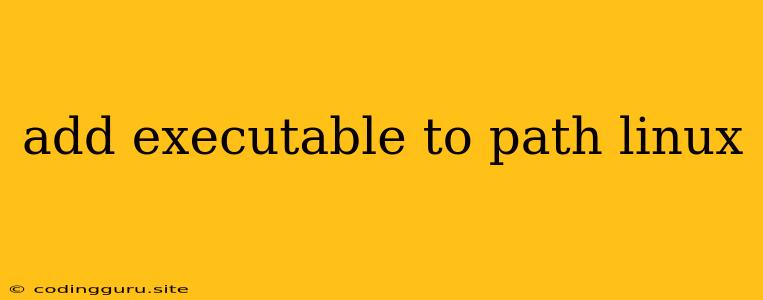Adding Executables to Your PATH on Linux: A Comprehensive Guide
Navigating the world of Linux, especially for beginners, can often feel like a journey through a labyrinth. One of the first hurdles you'll likely encounter is the concept of the PATH environment variable. This seemingly simple string of directories holds the key to making your life easier by allowing you to execute programs from any location on your system.
But what exactly is the PATH and why should you care about adding executables to it?
Understanding the PATH
Imagine you have a program called myprogram stored in /home/user/bin. To run this program, you typically have to type the full path:
/home/user/bin/myprogram
That can get tedious quickly, especially if you use the program frequently. This is where the PATH comes in.
The PATH is a system variable that tells your shell where to look for executable programs. When you type a command like myprogram, your shell will search through each directory listed in the PATH until it finds the executable file.
Why Add Executables to PATH?
Adding executables to your PATH offers several advantages:
- Convenience: You no longer need to specify the full path to the executable, saving you time and effort.
- Consistency: You can run the same command from any directory on your system, ensuring a uniform experience.
- Organization: By placing commonly used executables in a dedicated directory, you can keep your system organized.
Methods for Adding Executables to PATH
There are several ways to add executables to your PATH on Linux. Let's explore the most common methods:
1. Temporary Modification: Using the PATH Environment Variable
The simplest way to modify the PATH is to use the export command. This change is only temporary and will be lost when you close the current shell session.
Example:
export PATH=$PATH:/home/user/bin
This command appends the directory /home/user/bin to the existing PATH. You can now run myprogram without specifying the full path.
2. Permanent Modification: Editing the ~/.bashrc File
To make the changes to your PATH persistent across sessions, edit the ~/.bashrc file. This file is executed whenever you open a new terminal window.
Steps:
-
Open the
~/.bashrcfile with a text editor:nano ~/.bashrc -
Append the following line to the end of the file:
export PATH=$PATH:/home/user/bin -
Save and close the file.
-
Open a new terminal window for the changes to take effect.
3. System-Wide Modification: Editing the /etc/profile File
If you want the changes to apply to all users on the system, you can edit the /etc/profile file. This file is executed for every user when they log in.
Steps:
-
Open the
/etc/profilefile with root privileges:sudo nano /etc/profile -
Append the following line to the end of the file:
export PATH=$PATH:/home/user/bin -
Save and close the file.
-
Log out and log back in for the changes to take effect.
Caution: Modifying system-wide configuration files should be done with caution, as incorrect edits could potentially disrupt your system.
Best Practices for Managing Your PATH
- Use Dedicated Directories: Create specific directories for your executables, such as
/usr/local/binor/home/user/bin, for better organization. - Avoid Unnecessary Directories: Don't add directories that are not directly related to your programs, as it can slow down the search process.
- Test Carefully: After making changes to your PATH, test the commands to ensure they work as expected.
- Document Your Changes: Keep a record of the changes you make to your PATH for easy reference and troubleshooting.
Troubleshooting PATH Issues
If you encounter issues with your PATH, you can use the following techniques to diagnose the problem:
-
Check the current PATH:
echo $PATH -
Verify File Permissions: Ensure that the executable files you're trying to run have the necessary permissions (read and execute) for your user.
-
Use the
whichCommand:which myprogramThis command will tell you the full path to the executable file, if it's found in your PATH.
Conclusion
Adding executables to your PATH is a fundamental skill for navigating the Linux command line. By understanding the concept of the PATH and following the best practices outlined above, you can streamline your workflow, save time, and make your Linux experience much more enjoyable.
